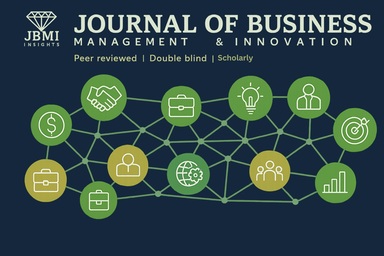Influence of Risk Identification on Project Implementation in Regulatory State Corporations in Kenya
Abstract
To effectively implement enterprise risk management, it's crucial to examine different strategic paths by considering the interconnected risks present in various possible situations, which helps in identifying opportunities arising from risks and ensuring that risk management aligns with the acceptable level of risk for stakeholders. This motivated the aim of the study which sought to examine the influence of enterprise risk management on project implementation in the public sector in Kenya with a focus on the regulatory state corporations. The specific objective was to evaluate risk identification affect project implementation in the regulatory state corporations in Kenya. The theories anchoring the study are agency theory, fraud triangle theory and stakeholder theory. To achieve the above objectives, the study adopted a descriptive research design. The target population was all the 122 officials in charge of implementing projects and therefore the study was a census survey who were selected from regulatory state corporations. A questionnaire was used to collect data from the respondents in the regulatory state corporations. Data was analyzed using descriptive and inferential statistics which included percentages, means, standard deviation and linear regression models. The findings were presented in the form of tables. From the study findings, it can be concluded risk identification had a positive and a significant effect on project implementation in regulatory state corporations in Kenya. For the future study, the study suggested a study to investigate the mediating role of organizational culture or leadership style in the relationship between enterprise risk management practices and project performance with a focus in the private. A comparative study can be conducted across sectors (e.g., private vs. public) to understand contextual differences in enterprise risk management implementation.
Keyword: Risk Identification, Project Implementation, Regulatory, State Corporations, Kenya
References
Agustina, L. & Baroroh, N. (2016). The Relationship Between Enterprise Risk Management (ERM) And Firm Value Mediated Through Financial Performance. Review of Integrative Business and Economics Research, 5 (1), 128 - 138.
Becker, J., Ringle, C. & Sarstedt, M. (2020). “Estimating moderating effects in PLS - SEM and PLSc-SEM: Interaction term generation data treatment”, Journal of Applied Structural Equation Modeling, 2 (2), 1 - 21
Deloitte (2018). India Corporate Fraud Perception Survey 2018. India: Deloitte.
Gómez-Cabrera, A., Sanz-Benlloch, A., Montalban-Domingo, L., Ponz-Tienda, L., & Pellicer, E. (2020). Risk identification factors affecting the performance of rural road projects in Colombia. Road Sustainability Journal, 12(18), 73 - 77.
Hidayah, N., Azhar, Z., Setiany, E., Utami, W. & Tarmidi, D. (2024). Determinants of ERM quality and its impact on company value. Business: Theory and Practice, 25(1), 11–23.
Jensen, M., & Meckling, W. (1976). Theory of the firm: Managerial behavior, agency costs, and ownership structure. Journal of Financial Economics. 3 (4), 305 - 360.
Kiprono, J. & Ng’ang’a, P. (2018). Fraud management practices and financial performance of Kenya Ports Authority. International Academic Journal of Economics and Finance, 3(2), 241-264.
Makhdumi, F. & Taha El Baba, A. (2022). Risk identification approaches in mega construction projects in developing countries: cases from Pakistan (UMEA, University).
Minja, D. & Muthinja, M. (2024) Effect of project identification on the performance of road infrastructure development projects in Kenya. Reviewed International Journal, 5 (1), 2 - 18.
Mitnick, B., (2013). Origin of the Theory of Agency: An Account by One of the Theory's Originators.
Mugenga, M. & Bugingo, E. (2024) Effect of risk management on the performance of construction projects in Musanze District, Rwanda (Project Ines-Busogo, Gs' Kampanga Road). Brainae Journal. 8 (3), 1 -15.
Murray, S. & Jonne's, N. (2021) Temporary inter-organizational projects: How temporal and social embeddedness enhance coordination and manage uncertainty. In The Oxford Handbook of inter-organizational relations (1–27).
Mutula, O. & Engairo, P. (2024). Effect of Risk Identification on Project Implementation among Faith-Based Construction Projects in the Diocese of Ngong. International Journal of Social Science and Humanities Research, 2(1), 31-39.
Nasreddine, A., Ideris, Z., Alferjany, A., & Akram, A. (2023). The Effect of Risk Identification Practices on Project Performance: A Case Study of the Libyan Construction Industry. International Journal of Professional Business Review, 8(6), 1 - 12.
PMI (2018) A Guide to Project Management. Body of Knowledge (PMBoK Guide). 5th Edition, Project Management Institute, Newtown Square, PA, USA.
Qinthara, H., Sutari, W., & Salma, S. A. (2021). Design of Risk Management System on Material Handling Services to Fulfill ISO 9001: 2015 Requirements Clause 6.1 Based on ISO 31000: 2018. Journal Knowledge Industrial Engineering, 8(3), 154-166.
Warburton, R. & Cioffi, D. (2014). Project management theory: deriving a project's cost and schedule for its network structure. Project Management Institute Research and Education Conference.
Yousri, E., Sayed, B., Farag, M. & Abdelalim, M. (2023) Risk Identification of Building Construction Projects in Egypt. Buildings. 8 (13), 11 - 24.





